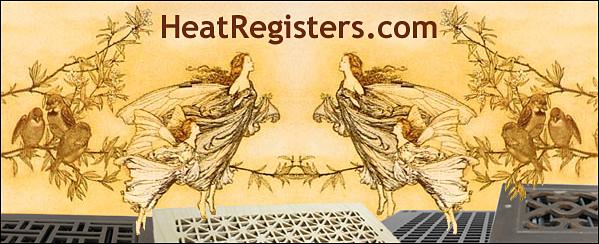
Heat Registers
Heat registers are something that you would think had become fairly standardized through the years and that would be available in a fairly limited menu of sizes and styles. Nothing could be further from the truth! There is a bewildering array of styles and sizes that can become very confusing since some heat registers will work in certain locations and others with the same dimensions but perhaps a different construction material or method will not. It is too risky to acquire heat registers through a shopping cart type system, especially if your duct openings are not exactly standard sizes. A heat register might be able to work in a non standard size, or it might not. Our knowledgeable professionals can provide expert guidance and help avoid costly and irritating mistakes and delays regarding size issues and other potential pitfalls.Heat register locations
A heat register that is located on the floor must be able to successfully tolerate foot traffic. Even if you think you will never step on floor registers I'm sure we can all agree that it is wise to plan for that eventuality. Heat registers are usually located in out of the way locations such as under a window, occasionally you'll find them right in the traffic pattern. This may be because the house was retrofitted with an HVAC system later (typical of vintage charmers), or maybe a wall had been knocked out in the past thus exposing the hvac registers that were formerly somewhat out of the way.
Heat registers on the wall or ceiling present fewer problem since weight requirements are not an issue. This opens up a world of opportunity for ornate cast resin pieces that simulate cast iron, for wood registers that may be ornately carved and too delicate for floor use, and even for sturdy steel registers for whom the faceplate design is too ornate to use where feet will trod.
Materials used in construction of heat registers
We are all familiar with the common wooden types seen at big box stores that have slanted slats. Did you know that many of those units which appear to be oak actually use some kind of unknown wood that simulates oak? Why bother with some pulpy mystery wood when it hardly costs any more to get the real thing? Also, the quality of joinery used to hold the parts together is very important. We are proud to say that the integrity of the joinery on our wood registers is superb. If you install wood flush mount registers in a new floor, the entire floor gets sanded and then varnished. At that point the register are some new undetermined thickness. If you have a flush mount register disintegrate due to bad quality joinery then it is not possible to buy a new heat register off the shelf and have it fit correctly. It will be too tall since it was not sanded down with the floor originally. It would have been much better to get a high quality flush mount heat register in the first place and just avoid the grief completely. As a point of interest, if you have a poorly made flush mount wooden heat register fall apart, do not throw away the parts. Call us up and we can make arrangements for you to send in the parts and we can fabricate a new gut portion with exactly the same measurements. It's something you'd rather not do, but it is nice to know that an option exists for this kind of catastrophic situation.
Depending upon the type of wood heat registers you choose there are many possibilities for your choice of woods. The most typical is red oak, but also very popular is paint grade maple, white oak, hickory, walnut, birch, white pine, and many more.
Aside from wood heat registers, there are also many types of metal registers. Some metal heat registers are cast in a mold. These are typically made of cast iron, cast bronze, aluminum, or brass, and sometimes feature finishes such as polished copper, polished brass, patinated bronze, hand applied heat treated patinas, brushed nickel, antique brass, and black. Our metal heat registers that are not cast in a mold are available in various powder coat or plated finishes including black, brown, paint ready white, silver, almond, brushed stainless steel and more.
An intriguing type of heat register is the type made from cast resin. At first blush that doesn't seem all that interesting, but when painted these are virtually indistinguishable from cast iron, but with greater detail and ease of installation. Furthermore, they are relatively light and so using them in a ceiling application is certainly workable and much less stress inducing, especially if you live in earthquake country.
Heat registers in oddball custom sizes
Who can say why some HVAC ducts are unusual sizes? But the fact of the matter is that there are some very unlucky homeowners with some very challenging duct opening dimensions. We talk to them every day and usually they are very frustrated and at their wits end. If you are one of these poor unfortunates don't spend too much time looking around on our site, just give us a call and we'll ask a few pertinent questions and will be able to make some useful recommendations to steer you in the right direction. Most of our custom heat registers we are able to provide CAD drawings to you for approval and at that point changes can still be made, if necessary.





































